
The buzz about green buildings and energy conservation is so loud you just can't shut your ears to it. And why should you? We are being inundated with information on how to make our buildings and our lives greener. Even if your building can't afford an entire 'green' makeover, there are easy, cost-effective strategies that both boards and residents can implement to save money and energy.
Get Motivated!
Want your residents to become greener and more energy efficient? Motivate them, says Thomas Kostigen, co-author of The Green Book: The Everyday Guide to Saving the Planet One Simple Step at a Timewith Elizabeth Rogers (Three Rivers Press).
"Make residents aware of what they are already doing that's environmentally-friendly (such as recycling)," says Kostigen. "And don't make them feel guilty about what they are not doing."
In Los Angeles, Mozaic apartments, owned and managed by Lincoln Property Company, have sparked their residents to make more earth-friendly changes by providing a kick start—giving every resident a compact fluorescent light bulb. It's a start!
You can also start a 'green' tips section of any newsletter that your building may distribute, or on your website. Provide residents with the basic information they need and they will be more willing to make some changes.
Unfortunately, many people also equate being 'green' with spending more green, something not all residents will be able to afford. Laurel Kallenbach, senior editor of Natural Home magazine reminds everyone that yes, it costs more up-front, but to be patient and wait for the rewards - they will come.
"If you are going to buy a home and sell it a year later, you won't be there to recoup the outlay, but within five or 10 years you do get a return on your investment," says Kallenbach.
So where to start? Kallenbach says the first step is free—simply change your habits, such as taking shorter showers and not flushing when you don't have to. Kostigen agrees with these baby steps.
"If you change one light bulb, I salute that, but the more the better," says Kostigen, "Changing bulbs in standard lamps will use 66 percent less energy. If every home changed one light bulb, it would make a difference, but if the building changed multiple light bulbs, two-thirds of the energy can be saved. Not only from a building management standpoint, but a source reduction standpoint, it's a huge savings."
According to Energy Star, if every American home replaced just one light bulb with an Energy Star qualified bulb, we would save enough energy to light more than 3 million homes for a year, more than $600 million in annual energy costs, and prevent greenhouse gases equivalent to the emissions of more than 800,000 cars. Inspired?
Pull the Plug
Kostigen says that the next step would be to pull the plug on energy guzzling appliances.
"You may not realize that appliances are still consuming as much as 10 percent of your annual energy bill when they are turned off, but plugged in," he says.
He recommends installing power strips and plugging in multiple items, using the right size pots, and utilizing your energy-efficient microwave.
And once you pull the plug on your appliances, try changing them to Energy Star qualified appliances, says Michael Block, chief executive and principal at Kinetix LLC, in Manhattan, a firm that addresses sustainability issues with various companies.
"Energy Star qualified appliances incorporate advanced technologies that use ten to 50 percent less energy and water than standard models," says Block.
Block also advises boards to have residents "lower air conditioning set points by at least one to two degrees, and raise heating set points by the same. Each degree raised or lowered can save four to eight percent on energy costs."
"When washing clothes, a huge energy and water waster, about 80 to 85 percent of the energy used for washing clothes is used to heat the water," said Block. He suggests reducing this cost by using less water by washing full loads and using cooler water and cold-water detergents.
"Switching the temperature setting from hot to warm cuts a load's energy use in half," says Block.
Water Power
Lloyd Hathcock, director of program development at Niagara Conservation in Cedar Knolls, New Jersey, says the number one thing that residents and shareholders can do to conserve water is to fix drips.
"In a kitchen, if the faucet drips once every five seconds, that water is going down the drain and it's the volume equivalent of 50 to 100 gallons of water a day that's on the water bill," says Hathcock. "Fixing leaks can be done fairly cost effectively."
Test for leaks in your toilet by dropping blue or red food coloring into the tank, wait 10 minutes, and if that color develops in the bowl, it's leaking and needs to be replaced. "All the toilets on the market now, such as Niagara's flapperless toilet, are water efficient," he says.
After repairing the leaks, Hathcock says the next important step is to retrofit high-efficiency showerheads and faucet aerators. Aerators increase spray velocity, reduce splash and save water and conserve energy.
"If the showerhead was installed ten years ago, it probably has a flow rating of two to two-and-a-half gallons per minute or higher," says Hathcock. "A newer high-efficiency shower head uses only 1.5 gallons of water per minute." Cost? As little as $10 to $200 or more. "The flow rate on the shower heads is the same, but it's just the way it's constructed, the aesthetics and the spray patterns that makes it more expensive."
Kallenbach suggests not falling for a lot of other 'green gadgets.' "Timers and motion sensors are good if you don't want to leave the lights on all day, but I don't like 'gadgets'—they sometimes use batteries and cause their own waste."
Rearrange and Change
Jeffrey Mayer, president and chief executive officer of MXenergy, which provides both natural gas and electricity to customers across New York State, suggests another free energy saving option for residents—simply rearrange your furniture.
"Avoid placing lamps or TV sets near your air-conditioning thermostat," says Mayer. "These appliances create heat that the thermostat can sense, causing the air conditioner to run longer than necessary. And make sure you don't have any furniture blocking vents."
Clean Green
You hear it on the news every day—clean with 'environmentally safe,' 'non-toxic,' 'green' products and you'll be doing your home furnishings and the environment a good thing. The question is, how?
"Green products are non-petroleum based and made from biodegradable, renewable resources. And the ingredients sometimes foster a cleaner indoor air environment," says Jonathan Wels of DEC Green, a company that provides earth-friendly cleaning products, equipment and systems for the co-op and condo community. They are also safer for the employees using the product, Wels says, since many of the products have a neutral pH and no odor.
While we all want to believe that by simply calling a product 'green' it is a good product that's not necessarily true, according to the Consumer Specialty Products Association (CSPA). In terms of safety, the CSPA says that traditional cleaning products are extensively tested to ensure safety and environmental compatibility and contain carefully selected ingredients, many of them naturally-derived.
"They are used safely in millions of households, commercial establishments and public facilities every day to improve quality of life and reduce health risks," says the CSPA president, Christopher Cathcart. "There is no guarantee that a natural ingredient or product is any safer or better for the environment. While some natural ingredients are effectively used in cleaning products, it is simply wrong to automatically assume that traditional products are bad and natural ingredients are good."
Cathcart says that there really is no definition for so-called 'green cleaning.' "Consumers should choose products that effectively protect against viruses that cause cold, flu and diarrhea, and bacteria such as Salmonella and E. Coli," he says. "Claims for antimicrobials, such as 'kills 99 percent of germs,' need to be registered with the Environmental Protection Agency (EPA). Consumers can be confident that they are getting a product that effectively kills germs if they see the EPA registration number on their product. Many so-called 'green' products provide no such protection."
Cathcart also explains that consumers should consider the facts about products that claim to be 'green' or contain 'natural' ingredients, because such terms are increasingly used as a marketing device.
"Some 'green' labeling also could be misleading," Cathcart says.
That's why there is something called the Green Seal Standard, says Wels. "They have a benchmark on the effects on the environment and on human health. So when you say the products meet Green Seal Standards, they have been signed off by the not-for-profit, government regulated company," states Wels.
There are many green products on the market to choose from that are waterborne, non-toxic, pH neutral, non-hazardous, and contain no solvents, volatile organic compounds or VOCs, toxins, alcohol, ammonia, harmful oxygen-based bleach cleaners, or citrus-based products which may dissolve rubber or plastics. "They clean as well, if not better and cost the same, if not less than traditional products," says Wels.
For More Info
Boards can turn to various websites and organizations for more information and education on turning green. The New York State Energy Research and Development Authority (NYSERDA) has various programs depending on the size of your building. Smaller buildings can benefit from EmPower New York, with the focus on cost-effective electric reduction measures, particularly lighting and refrigerator replacements, as well as other cost-effective home performance strategies such as insulation, and health and safety measures. On-site energy use education provides customers with additional strategies for managing their energy costs.
Larger buildings can benefit from The New York Energy $mart Multifamily Performance Program, which harnesses the latest in building science technology and applies it specifically to your building's design and daily operation. Using a partner network, made up of engineers, energy consultants, and other industry professionals, the Multifamily Performance Program uses a customized approach to address the specific energy and operational needs of your building.
Lisa Iannucci is a freelance writer, published author and mother of three living in Poughkeepsie, New York.









3 Comments
Leave a Comment